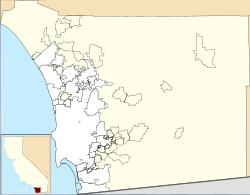
The Panama–California Exposition was a world exposition held in San Diego, California, between January 1, 1915, and January 1, 1917. The exposition celebrated the opening of the Panama Canal, and was meant to tout San Diego as the first United States port of call for ships traveling north after passing westward through the canal. The fair was held in San Diego's large urban Balboa Park. The park held a second Panama-California exposition in 1935.

San Diego Air & Space Museum is an aviation and space exploration museum in San Diego, California, United States. The museum is located in Balboa Park and is housed in the former Ford Building, which is listed on the US National Register of Historic Places. SDASM was established by articles of incorporation on October 12, 1961, and opened to the public on February 15, 1963.
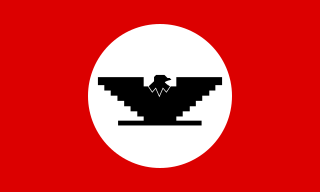
The Royal Chicano Air Force (RCAF) is a Sacramento, California-based art collective, founded in 1970 by Ricardo Favela, José Montoya and Esteban Villa. It was one of the "most important collective artist groups" in the Chicano art movement in California during the 1970s and the 1980s and continues to be influential into the 21st century.
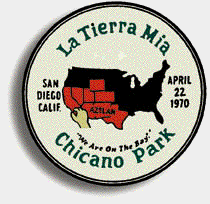
Chicano Park is a 32,000 square meter park located beneath the San Diego–Coronado Bridge in Barrio Logan, a predominantly Chicano or Mexican American and Mexican-migrant community in central San Diego, California. The park is home to the country's largest collection of outdoor murals, as well as various sculptures, earthworks, and an architectural piece dedicated to the cultural heritage of the community. Because of the magnitude and historical significance of the murals, the park was designated an official historic site by the San Diego Historical Site Board in 1980, and its murals were officially recognized as public art by the San Diego Public Advisory Board in 1987. The park was listed on the National Register of Historic Places in 2013 owing to its association with the Chicano Movement, and was designated a National Historic Landmark in 2016. Chicano Park, like Berkeley's People's Park, was the result of a militant people's land takeover. Every year on April 22, the community celebrates the anniversary of the park's takeover with a celebration called Chicano Park Day.

The Centro Cultural de la Raza is a non-profit organization with the specific mission to create, preserve, promote and educate about Chicano, Mexicano, Native American and Latino art and culture. It is located in Balboa Park in San Diego, California. The cultural center supports and encourages the creative expression “of the indigenous cultures of the Americas.” It is currently a member of the American Alliance of Museums.
Gilbert "Magu" Luján was a Chicano American sculptor, muralist, painter, and educator. He was a founding member of the Chicano collective, Los Four that consisted of artists Carlos Almaraz, Beto de la Rocha, Frank Romero and himself. In 1974, Judithe Hernández became the "fifth member," and only female member of Los Four.
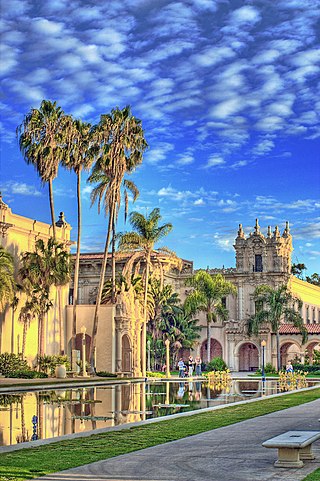
The California Pacific International Exposition was an exposition held in San Diego, California during May 29, 1935–November 11, 1935 and February 12, 1936–September 9, 1936. The exposition was held in Balboa Park, San Diego's large central urban park, which had also been the site of the earlier Panama-California Exposition in 1915.
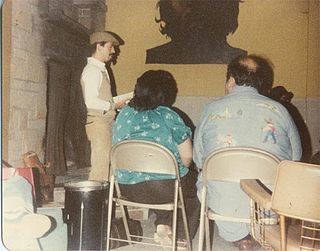
Alberto Baltazar Urista Heredia, better known by his nom de plume Alurista, is an American poet and activist. His work was influential in the Chicano Movement and is important to the field of Chicano poetry.

The San Diego Model Railroad Museum is a model railroad exhibit in San Diego, California. At 27,000 sq. ft., it is one of the largest such indoor exhibits in North America and the world. The museum is located on the lower level of the Casa de Balboa Building on the Prado in Balboa Park.

The Museum of Us is a museum of anthropology located in Balboa Park, San Diego, California, and is housed in the historic landmark buildings of the California Quadrangle.
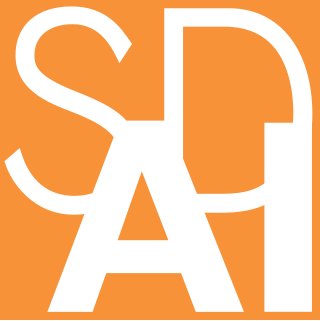
The San Diego Art Institute was a contemporary art museum with a focus on artists from the Southern California and Baja Norte region. It was founded in 1941 as the San Diego Business Men's Art Club. Its name was changed in 1950 to the San Diego Art Institute. In 1953, women were admitted for membership. It officially became a nonprofit in 1963. The San Diego Art Institute in Balboa Park and Lux Art Institute in Encinitas merged in September 2021 to become The Institute of Contemporary Art, San Diego, with each museum continuing to operate at its respective site.

The House of Charm is a historic museum building in Balboa Park, San Diego. It was built for the 1915–16 Panama-California Exposition, and like most buildings from that Exposition it features Mission Revival Style architecture. It acquired its current name, "House of Charm", during the park's second Exposition held in from 1935 to 36. It now houses the San Diego Art Institute and the Mingei International Museum as well as rehearsal space for the Old Globe Theatre. It is listed on the National Register of Historic Places.
Salvador Roberto Torres is a Chicano artist and muralist and an early exponent of the Chicano art movement. He was one of the creators of Chicano Park, and led the movement to create its freeway-pillar murals. He was also a founder of the Centro Cultural de la Raza in San Diego, California.

Balboa Park is a 1,200-acre (490 ha) historic urban cultural park in San Diego, California, United States. In addition to open space areas, natural vegetation zones, green belts, gardens, and walking paths, it contains museums, several theaters, and the San Diego Zoo. There are also many recreational facilities and several gift shops and restaurants within the boundaries of the park. Placed in reserve in 1835, the park's site is one of the oldest in the United States dedicated to public recreational use. Balboa Park is managed and maintained by the Parks and Recreation Department of the City of San Diego.

The Chicano Art Movement represents groundbreaking movements by Mexican-American artists to establish a unique artistic identity in the United States. Much of the art and the artists creating Chicano Art were heavily influenced by Chicano Movement which began in the 1960s.

The California Quadrangle, California Building, and California Tower are historic structures located in Balboa Park in San Diego, California. They were built for the 1915–16 Panama-California Exposition and served as the grand entry to the Expo. The buildings and courtyard were designed by architect Bertram Goodhue. They were added to the National Register of Historic Places on May 17, 1974. They now house the Museum of Us.
Guillermo Acevedo (1920-1988) was a Peruvian-born artist and master draftsman, most famous in the United States for his striking portrayal of Native Americans of the Southwest, and for his ability to capture and help preserve the disappearing architectural styles of old neighborhoods throughout the U.S. and abroad. Known to be an artist-observer with great sensitivity, Acevedo is recognized as a master at recording the human condition.
Victor Ochoa is an activist, painter, graphic designer and master muralist. He has painted over 100 murals, many of them in San Diego, California. He is considered one of the pioneers of San Diego's Chicano art movement. Ochoa was one of the original activists at Chicano Park and a co-founder of Centro Cultural de la Raza in Balboa Park, both in San Diego. He helped establish the influential Border Art Workshop/Taller de Arte Fronteriza (BAW/TAF). Ochoa is also a teacher of art and Chicano heritage. His work has been shown nationally and internationally, including at the Venice Bi-Annual, at the Museum of Contemporary Art, San Diego and in the groundbreaking exhibition, Chicano Art: Resistance and Affirmation (CARA). In addition to creating his own work, he is also a master of art preservation techniques, especially relating to murals. He is considered to be a "serious cultural resource in the border region.
Josephine "Josie" Talamantez is a historian from San Diego, California. She co-founded Chicano Park in 1970 and helped develop it into a cultural National Historic Landmark containing the largest collection of artistic murals in the United States. Talamantez was also the Chief of Programs for the California Arts Council, served as the director of the Centro Cultural de la Raza, and was on the board of the National Association of Latino Arts and Culture.
Elizabeth Sisco is an artist active in the Chicano art movement.


